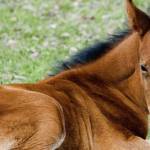Foal Pneumonia

Foal pneumonia is a common disease of young horses, and one of the leading causes of death in foals. Estimates put the incidence of infection as high in one in ten for all foals. Overall mortality is about 20%, but on some farms as many as 80% of affected foals may die.
What causes this disease?
Foal pneumonia can be viral or bacterial, but one of the most common causes is infection with Rhodococcus equi, a type of bacteria found in the soil. Adult horses often harbor R. equi without developing disease signs, but foals between two and six months are quite susceptible to infection. Normally, foals receive passive immunity to disease through intake of the mare’s colostrum in the first hours of life. Newborns that have not gotten adequate amounts of colostrum are at increased risk of illness, and this is often the situation when very young foals develop R. equi infection. This early protection begins to decline when the foal is about six or eight weeks old, the age at which pneumonia begins to occur. The incidence drops significantly at about six to eight months as young horses’ immune systems become stronger.
Most cases of R. equi pneumonia are thought to be caused by inhalation of dust that contains the bacteria. However, a recent study in Australia suggests that direct aerosol transmission is possible from sick to healthy foals.
What are the signs of foal pneumonia?
It is not uncommon to hear of a foal that seemed perfectly healthy and vigorous one day and died the next day from R. equi infection. Although this scenario does occur, in many cases early disease signs are present and are simply overlooked.
There is no one sign of illness that is invariably present in every case of foal pneumonia, but a careful check of foals will probably uncover some indication if disease is present. Things that might be noticed include:
• Difficulty breathing (might be more obvious when the foal is lying on its side than when it is lying on its sternum) or increased bronchial sounds.
• Body temperature above or below the normal range (99 to 102 degrees).
• Clear or yellow nasal discharge.
• Fatigue, exercise intolerance, or disinterest in nursing.
What treatments are used?
Treatment is most effective if the illness is detected early. A quick daily examination of each foal can uncover an elevated temperature, increased respiratory rate, coughing, or labored breathing. Although such examinations are time-consuming and require adequate personnel, the considerable cost of treating even one sick foal may balance the extra work.
If illness is suspected, a veterinarian should be consulted. The vet can culture bronchial secretions or use a blood test to determine what bacterial type and strain is causing the infection. Identifying the organism allows the vet to set up the most effective treatment plan.
R. equi infections can be treated with erythromycin estolate and rifampin given orally until two weeks after disappearance of clinical signs. This often means that foals must be medicated multiple times each day for six weeks or more. Treated foals have a tendency to overheat, whether because of the disease process or as a side effect of the medication, and should be closely monitored for dangerous rises in body temperature.
What can be done to prevent foal pneumonia?
There is no commercially available vaccine to protect against R. equi pneumonia. Researchers at the University of Guelph are working to develop a preventive vaccine, and are hopeful that it will be on the market in the next four to five years.
Some farms have gotten good results from treating very young foals with hyperimmune plasma before the start of hot weather. Given at one week and again at three to four weeks of age, this treatment can drastically lower the number of affected foals. The option is expensive and time-consuming, but may be cost-effective for farms with a history of high disease incidence.
Management steps are also effective in limiting the incidence of R. equi infections. Because the disease is spread by inhalation of bacteria-laden dust, keeping mares and foals out of dry, dusty areas helps control the disease. Outbreaks are somewhat more common during hot weather when pasture vegetation is depleted and the soil becomes dry. Even if many areas of the field are still grassy, shady spots and areas around water troughs tend to become bare and dusty. Any measures that minimize airborne dust—rotating pastures, limiting herd size in small fields, wetting down lanes and barn aisles—can decrease the chance of infection.
Although R. equi infection is often expressed as a respiratory disease, the bacteria can also colonize the digestive tract, causing diarrhea, abscesses, and a pot-bellied appearance. Even when infected foals do not develop gastrointestinal infection, the bacteria are present in their manure. For this reason, regular removal of manure from mare and foal paddocks can minimize contamination of the soil and limit the spread of airborne bacteria.
What is the prognosis for a foal that has Rhodococcus equi pneumonia?
When illness is found quickly and treatment is started promptly, most cases of foal pneumonia have a favorable outcome. Foals with severe lung lesions or intestinal abscesses may not respond as well to treatment, and relapse is not uncommon.
Studies of Thoroughbred foals with a history of pneumonia show that fewer of these foals reach the racetrack than their healthy peers. However, the ones that do enter training have similar performance records to healthy young horses, earning comparable amounts during their two-year-old and three-year-old racing seasons.








